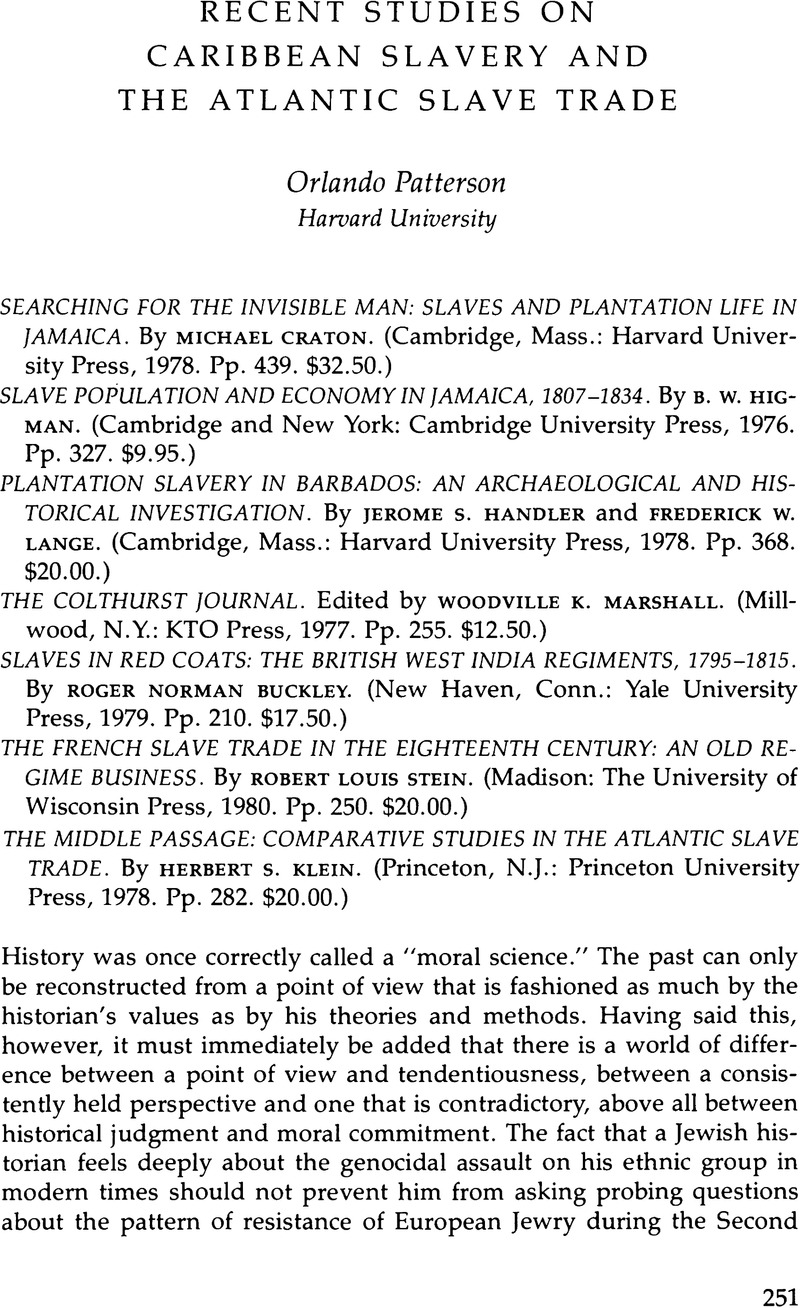Published online by Cambridge University Press: 24 October 2022

1. Incidentally, I was gratified to learn recently from Richard Dunn, who is now completing a study of Mesopotamia plantation in Jamaica which has even richer data in this regard than Worthy Park, that his work supports my thesis that Jamaican slave women deliberately restrained their childrearing capacities as a form of protest against the slave system.
2. For earlier works see: W. J. Gardner, A History of Jamaica (London, 1873); Mary Gaunt, Where the Twain Meet (London: John Murray, 1922); F. W. Pitman, “Slavery on the British West Indian Plantations in the Eighteenth Century, Journal of Negro History 11 (1926); Martha Beckwith, Black Roadways (Chapel Hill: University of North Carolina Press, 1929); Winfred M. Cousins, ”Slave Family Life in the British Colonies, 1800–1834,“ Sociological Review 27 (1935):35–55. For more modern works see: Edward Brathwaite, The Development of Creole Society in Jamaica, 1770–1820 (Oxford: Clarendon Press, 1971); Philip D. Curtin, Two Jamaicas (Cambridge, Mass.: Harvard University Press, 1968); Douglas Hall, ”Slaves and Slavery in the British West Indies,“ Social and Economic Studies 11 (1962):305–18; B. W. Higman, ”The Slave Family and Household in the British West Indies, 1800–1834,“ Journal of Interdisciplinary History 6 (1975):261–87; Fernando Henriques, Jamaica (London: MacGibbon and Kee, 1960); Sidney W. Mintz, Caribbean Transformations (Chicago: Aldine Publishers, 1974); Orlando Patterson, The Sociology of Slavery (London: MacGibbon and Kee, 1967); M. G. Smith, The Plural Society in the British West Indies (Berkeley: University of California Press, 1965).
3. In The Sociology of Slavery I pointed out that there was a stereotype of the typical slaves held by whites which the latter called Quashie. I noted that this stereotype was similar to the “Sambo” stereotype held by American slaveholders and was careful to note that this finding not only contradicts Stanley Elkins' claim that “Sambo” was a uniquely American stereotype, but, more importantly, was a part of the political psychology of oppression and not a description of how slaves actually were. Many critics of Elkins have cited my argument against him. Craton, amazingly, not only implies that I hold the view of Elkins that all slaves were in fact “quashies” but proceeds to attack this erroneous construction by the specious technique of showing that the seven slaves called Quashie on Worthy Park “demonstrated qualities of skill, adaptability and leadership” (p. 423, n. 10)!
4. On Jamaica see J. Stycos and K. Back, The Control of Human Fertility in Jamaica (Ithaca, N.Y.: Cornell University Press, 1964); Orlando Patterson, The Condition of the Low Income Population in the Kingston Metropolitan Area (Kingston: Government of Jamaica, 1973). On the Caribbean in general see R. T. Smith, “Culture and Social Structure in the Caribbean,” Comparative Studies in Society and History 6, no. 1: M. G. Smith, West Indian Family Structure (Seattle: University of Washington Press, 1962).
5. See Edith Clarke, My Mother Who Fathered Me: A Study of the Family in Three Selected Communities in Jamaica (London: George Allen and Unwin, Ltd., 1957), especially chapters 4 and 5.
6. It was possible to assign the sex of only 39 of the 92 interments (p. 161 and appendix A). In desperation, the authors were sometimes reduced to reporting spurious correlations. Of what use, for example, could it be to even the most assiduous student of West Indian slavery to learn that “The Newton data suggest no relationship between dental pipe wear and the presence of whole pipes” (p. 165)?
7. For examples of archival studies revising these estimates—nearly all, incidentally, increasing Curtin's estimates—see the papers by Roger Anstey, Johannes Postma and E. Philip LeVeen as well as Curtin's response in part 1 of Stanley L. Engerman and Eugene D. Genovese, eds., Race and Slavery in the Western Hemisphere: Quantitative Studies (Princeton, N.J.: Princeton University Press, 1975); and the collection edited by Henry A. Gemery and Jan S. Hogendorn, The Uncommon Market: Essays in the Economic History of the Atlantic Slave Trade (New York: Academic Press, 1979).